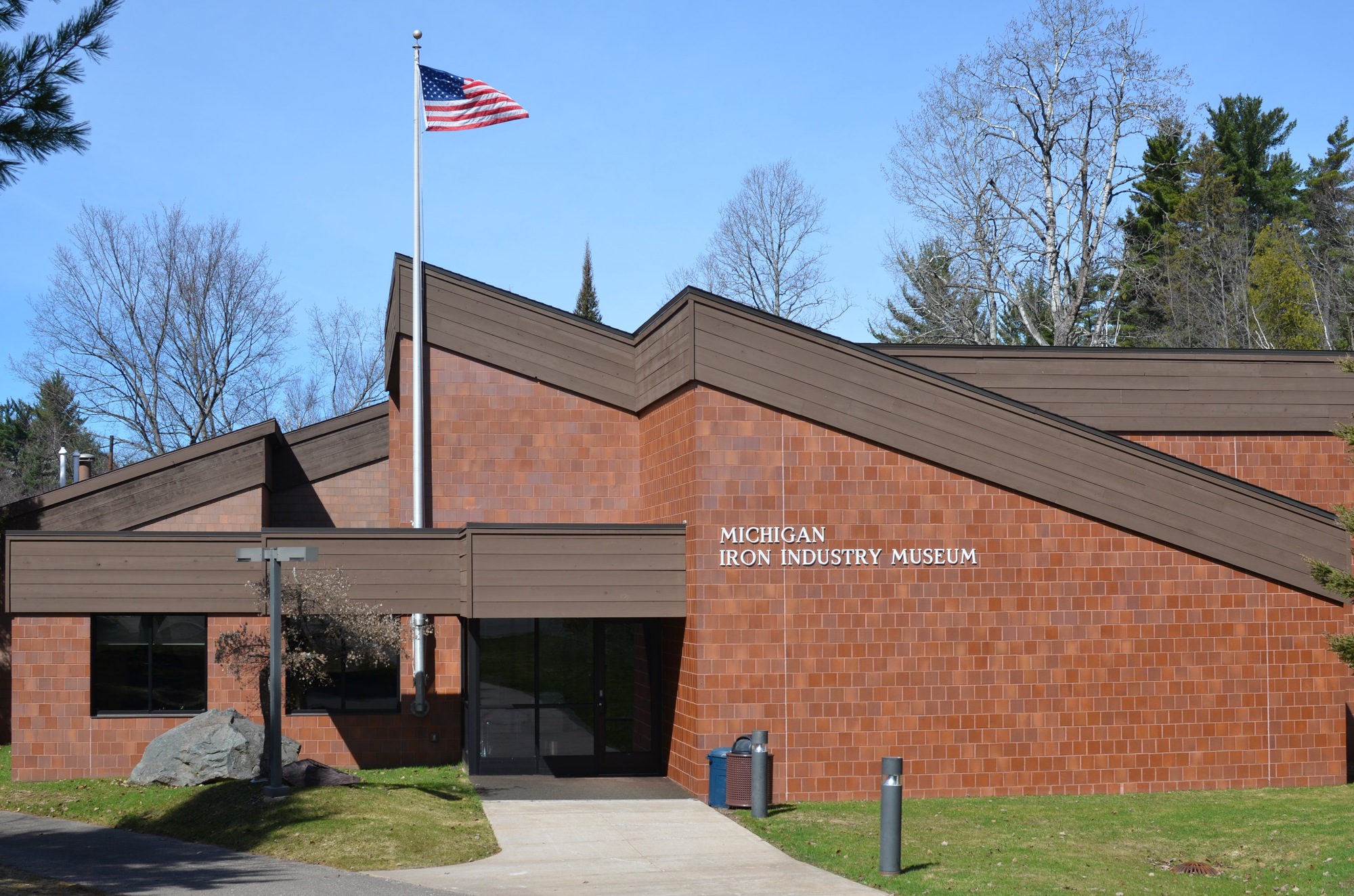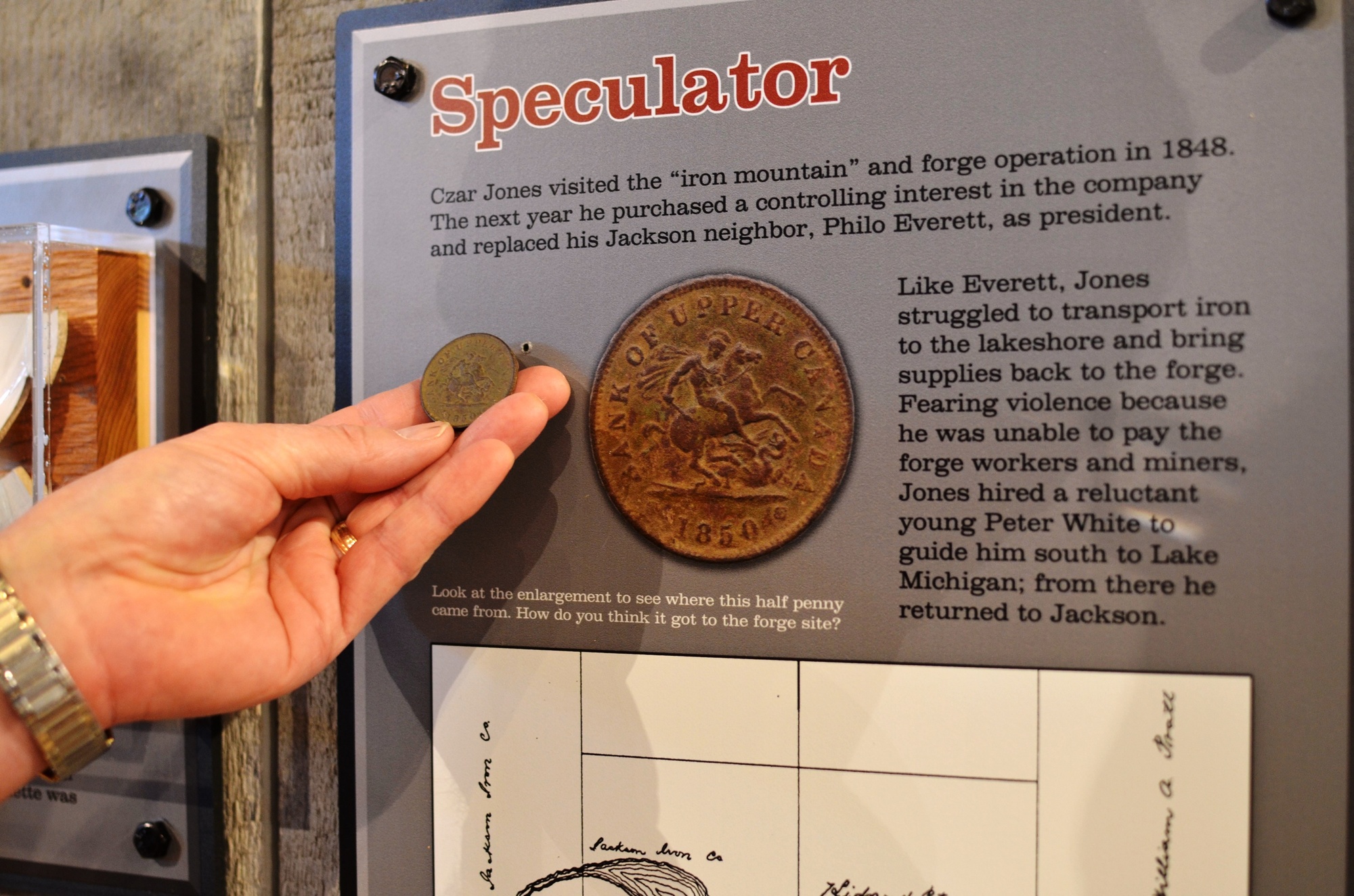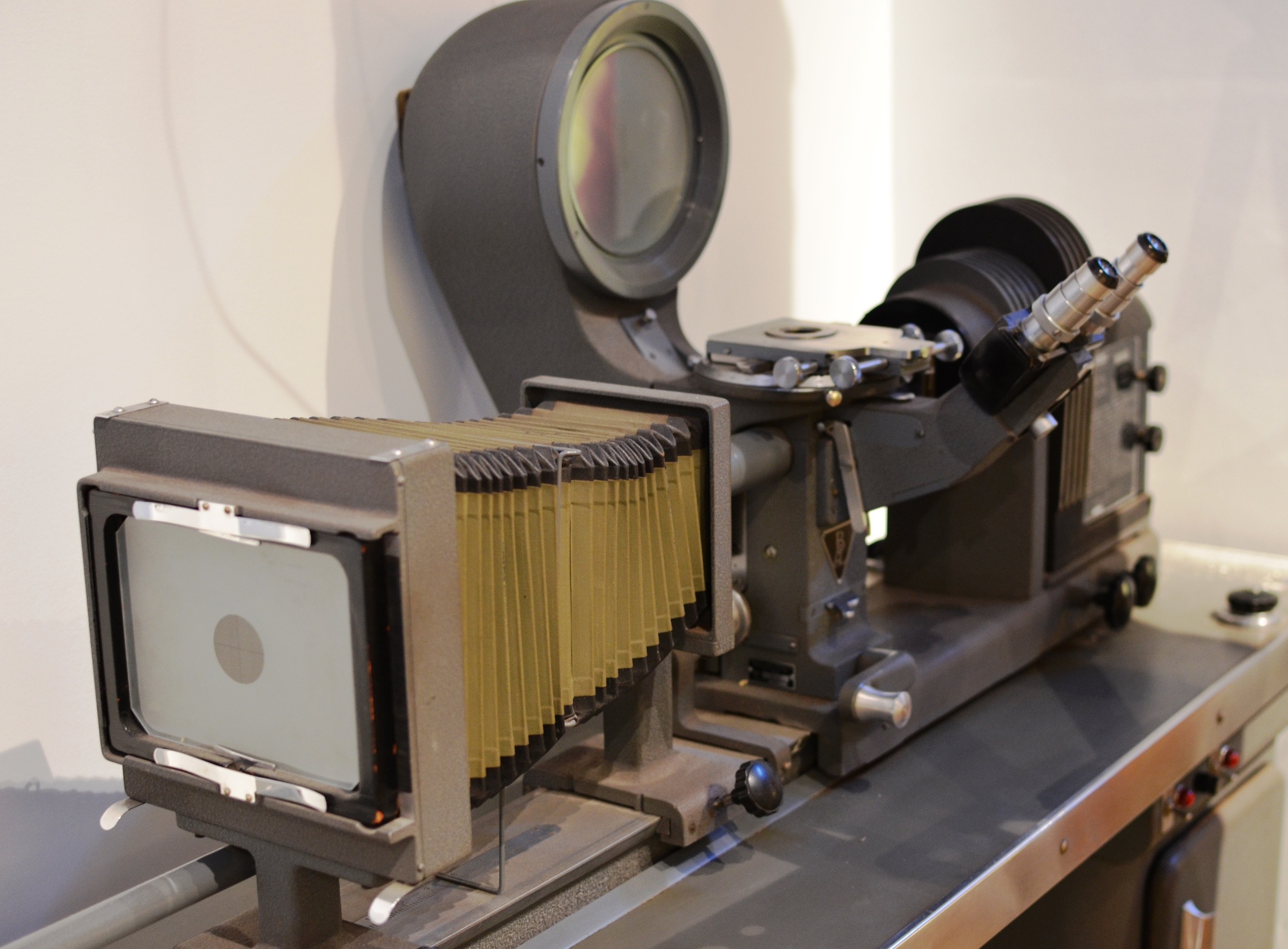Fishhooks and microscopes: New exhibits at Michigan Iron Industry Museum bring history into focus
A tiny, slender fishhook and a microscope so bulky it takes four people to lift it are among the interesting artifacts now on display in new exhibits at the Michigan Iron Industry Museum in Negaunee.
The museum, which showcases the Upper Peninsula’s iron ore mining heritage, is one of 11 nationally accredited museums administered by the Michigan History Center, an agency within the Michigan Department of Natural Resources.
 The museum overlooks the site of the Carp River Forge, a pioneer industrial location listed on the National Register of Historic Places. The museum overlooks the site of the Carp River Forge, a pioneer industrial location listed on the National Register of Historic Places.
Over the past several weeks, visitors to the museum have heard the sounds of drills and hammers as Michigan History Center staff has been busy installing the new exhibits.
“In some cases, the artifacts are not what you would expect to see in a museum devoted to the iron industry,” said DNR historian Troy Henderson. “But they all figure into the compelling stories about people who took part in this longstanding and still active industry.”
The fishhook was unearthed at the site of the Carp River Forge by Michigan Technological University archaeologists in 1998. The forge operated from 1847 until 1855 and smelted the first iron ore on the Lake Superior iron ranges.
The museum itself is a stone’s throw from that historic forge site and offers views of the meandering Carp River through its gallery windows.
“Artifacts from this pioneer site tell us a lot about the iron forging process and the people who actually lived here in the 1840s and 1850s,” Henderson said.
It is impossible to tell exactly which people who lived on the site once handled the pipes, spoons, colorful ceramic plate fragments and coins that are now on display. However, the exhibit’s selection and arrangement of artifacts blend with images and graphics to tie stories of the inhabitants together.
“Designing an exhibit takes a lot time and effort and it involves a lot of people,” exhibit designer Meagan Papineau said. “One of the more enjoyable aspects of this project was to look at the actual artifacts found on site and to match them with people and their stories.” said. “One of the more enjoyable aspects of this project was to look at the actual artifacts found on site and to match them with people and their stories.”
Henderson said one of the more interesting people he researched for the exhibit was William Lemm.
“Lemm, a carpenter and boastful fisherman and hunter, moved to the Carp River site in 1847 from downstate and helped build the forge and probably dwellings,” Henderson said.
Lemm remained in the Upper Peninsula after the short-lived forge operation. He guided a Harper’s Magazine correspondent through the Pictured Rocks in neighboring Alger County in the 1860s.
Henderson said the correspondent drew a sketch of Lemm for the article, who posed with his trusty rifle near a boat named after his daughter, the Cora E. Lemm.
Industrial and domestic household artifacts from the Carp River Forge offer a glimpse of the lives of the Marquette Iron Range pioneers.
Ceramic fragments found at the site matched intact plates and pitchers from the Michigan History Museum collections. Even though this frontier community was remote, its residents enjoyed goods from regional and even global markets.
A new interactive map of the Carp River Forge invites younger museum visitors to use archaeological evidence to explore where people lived and worked in the area surrounding the forge.
 “Much of what we know about the forge settlement stems from archaeology, and this interactive approach reinforces the importance of learning through tangible artifacts,” Henderson said. “Much of what we know about the forge settlement stems from archaeology, and this interactive approach reinforces the importance of learning through tangible artifacts,” Henderson said.
Other residents highlighted in the Carp River Forge exhibit include a father and son duo who hammered the first wrought iron at the forge.
Ariel and Samuel Barney arrived at what is now Marquette in the summer of 1847 and trekked 12 miles inland to the Carp River Forge site. By winter, the forge was constructed and the hearth fires were stoked for the smelting process.
Samuel Barney, who was a young man during his first U.P. winter, stayed in the area and raised a family. He occasionally revisited the overgrown, abandoned location later in life to reminisce.
When Barney died in 1910, his death certificate listed his occupation as “ironmaker.”
“He had not worked at the forge for over 50 years, but the experience defined him,” said Barry James, a historian at the museum.
“There is a legacy to this short-lived enterprise,” James said. “This was the seed from which Michigan’s iron industry grew, and as early as 1904 this historic site was commemorated.”
A 1904 monument remains in place today – barely visible through the trees from the museum, on the opposite side of the river.
Another exhibit in progress tells a story from the 20th-century, Marquette-area iron industry. The focal artifact of the exhibit is a desk-sized microscope. of the exhibit is a desk-sized microscope.
The microscope belonged to Tsu Ming Han, who was a research scientist with Cleveland-Cliffs Co. for a half-century beginning in the mid-1950s.
“Tsu Ming Han has an interesting personal story,” Henderson said. “And his microscope represents the industry’s heavy investment in research and development to discover how to process abundant low-grade ore and make it shippable and saleable on a large scale.”
During and after World War II, the high-grade ore – that could be directly shipped from Marquette County – was becoming scarce.
With depletion of that resource on the horizon, mining companies put major effort into developing and improving the process of creating pellets from low-grade ore.
“This work extended the life of the Lake Superior iron ranges,” James said. “It also dramatically changed the nature and the landscape of iron mining.”
Panoramic backdrops for the Han exhibit are installed. More artifacts and interpretive panels will be added later this season to complete the exhibit.
Part of what is yet to come is a comparison of a miner from 1900 and a modern miner.
“There have been a lot of changes over the past century-and-a-half in this industry, and this museum illustrates those changes, as well the role of the industry in building our iron range communities,” Henderson said.
The new exhibits are expected to command a good deal of attention when the museum holds its annual open house Sunday, marking the start of a summerlong series of family-friendly programs and events.
The museum is open daily from 9:30 a.m. to 4:30 p.m. through Oct. 31 and is located 8 miles west of Marquette, with entry via a half-mile drive off U.S. 41.
Admission to the Michigan Iron Industry Museum is free; donations are appreciated. Some special programs have fees for participation or parking.
For information about the open house or upcoming events at the museum, call 906-475-7857 or visit www.michigan.gov/ironindustrymuseum.
Check out more information on the Michigan Historical Center.
Catch upcoming stories by subscribing to free, weekly “Showcasing the DNR” articles. Previous articles are available at www.michigan.gov/dnr-stories.
/Note to editors: Contact: Troy Henderson, 906-475-7857 or John Pepin, 906-226-1352. Accompanying photos are available below for download and media use. Suggested captions follow. Credit: Michigan Department of Natural Resources.
Display: Steven Ostrander, a historian with the Michigan History Center, works on installing a display that is part of the Carp River Forge exhibit. Looking on are exhibit designer Meagan Papineau of the Michigan History Center and museum historian Troy Henderson.
Exhibit: Exhibit designer Meagan Papineau of the Michigan History Center works on the Carp River Forge exhibit at the Michigan Iron Industry Museum in Negaunee.
Half: A half-penny artifact from the Carp River Forge is shown next to an exhibit display that discusses the coin.
Ladder: Carpenter Paul Goodenough of the Michigan History Center works on a display case for the microscope of Tsu Ming Han, who was a research scientist with Cleveland-Cliffs Co. for a half-century beginning in the mid-1950s.
Microscope: The microscope of Cleveland-Cliffs Co. research scientist Tsu Ming Han used to help develop the process of pelletizing low-grade ore, effectively extending the life of mining efforts in Marquette County.
Museum: The Michigan Iron Industry Museum is featuring two new exhibits that highlight early and later efforts to mine and process iron ore in Marquette County./
The Michigan Department of Natural Resources is committed to the conservation, protection, management, use and enjoyment of the state’s natural and cultural resources for current and future generations. For more information, go to www.michigan.gov/dnr.
|

 The museum overlooks the site of the Carp River Forge, a pioneer industrial location listed on the National Register of Historic Places.
The museum overlooks the site of the Carp River Forge, a pioneer industrial location listed on the National Register of Historic Places. said. “One of the more enjoyable aspects of this project was to look at the actual artifacts found on site and to match them with people and their stories.”
said. “One of the more enjoyable aspects of this project was to look at the actual artifacts found on site and to match them with people and their stories.” “Much of what we know about the forge settlement stems from archaeology, and this interactive approach reinforces the importance of learning through tangible artifacts,” Henderson said.
“Much of what we know about the forge settlement stems from archaeology, and this interactive approach reinforces the importance of learning through tangible artifacts,” Henderson said. of the exhibit is a desk-sized microscope.
of the exhibit is a desk-sized microscope.




